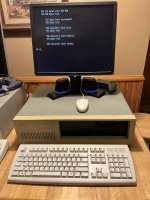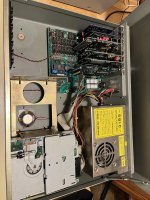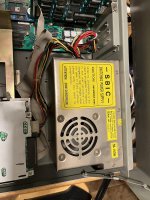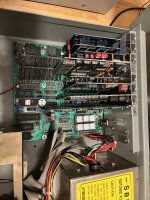jasa1063
Experienced Member
I got a Pravetz-16ES computer from Bulgaria that ended having both ST-225 hard drives damaged in shipping. Here is the original post of that computer:
I wanted to keep the computer completely original, but with the hard drives damaged that was not going to happen. It was at that point I decided to do upgrades with as many period correct parts as possible. The computer itself is nothing exotic. It is basically a Turbo XT clone with off the shelf parts put together in Pravetz, Bulgaria. The case is pretty cool as it has two buttons you push to release two clips then just raise it and it locks into place, kind of like the hood of a car. The power supply is 220v so I had to use a Step Up/Down transformer. Here are the original specs of the computer:
Juko Super ST OEM motherboard
NEC V20@8MHz overclocked to 12MHz
640K memory
Serial Card with two RS-232 ports (DB25 & DB9) with a RTC clock (Unknown vendor)
Parallel port card (Unknown vendor)
Full length CGA video card (unknown vendor)
MFM drive controller (Unknown vendor)
2x ST-225 5.25" hard drives
Floppy controller (Unkown vendor)
Chinon FZ-502 360K floppy drive
I had two black face plates that fit perfectly to take up the space that was occupied by the two ST-225 hard drives. I removed the MFM drive controller, Serial and Parallel cards. This is the final configuration with the upgrades I did:
Juko Super ST OEM motherboard (Original)
NEC V20@8MHz overclocked to 12MHz (Original)
Intel 8087-1@12MHz (?)
640K memory (Original)
Everex EV-170 Multi I/O card (Parallel & Serial) (1990)
Adlib clone sound card from Sun-Moon-Star (1992)
Game Port card (Unknown vendor) (1990)
ATI Edge VGA 8 video card (1988)
Xircom PE310BT Parallel Ethernet Adapter (Using mTCP for networking) (1994)
Blue Lava Systems XT-IDE CF adapter with 2GG SanDisk Ultra Compact Flash card (Modern)
Lo-Tech 1MB memory card with 64K @ D000 for upper memory (Modern)
Lo-Tech 2MB EMS card with Page Frame @E000 (Modern)
Tandy 1000 SmartWatch+ No slot RTC from Cybernetic Systems (Modern)
Floppy controller (Unkown vendor) (Original)
Chinon FZ-502 360K floppy drive (Original)
Overall I think I did a pretty decent job striking a balance between period correctness and functionality. I had the Tandy 1000 SmartWatch+ laying around for a couple of years, so it was nice to finally be able to put it to good use. I was a bit worried about the 8087-1 and overclocking. I am not really sure if this motherboard runs the 8087 at 12MHz or not. Benchmarks would seem to indicate more in the 10MHz range. Nevertheless, I added heat sinks to the NEC V20 and 8087 to better be able to handle any additional heat. I ran through a complete Mandrbot set @640x480x16 that uses the 8087 and then ran the full 5 minute test using Intel's MCPDiag program and finally CheckIt 3.0. The 8087 checked out just fine. Attached are a few photos of the final build.
I wanted to keep the computer completely original, but with the hard drives damaged that was not going to happen. It was at that point I decided to do upgrades with as many period correct parts as possible. The computer itself is nothing exotic. It is basically a Turbo XT clone with off the shelf parts put together in Pravetz, Bulgaria. The case is pretty cool as it has two buttons you push to release two clips then just raise it and it locks into place, kind of like the hood of a car. The power supply is 220v so I had to use a Step Up/Down transformer. Here are the original specs of the computer:
Juko Super ST OEM motherboard
NEC V20@8MHz overclocked to 12MHz
640K memory
Serial Card with two RS-232 ports (DB25 & DB9) with a RTC clock (Unknown vendor)
Parallel port card (Unknown vendor)
Full length CGA video card (unknown vendor)
MFM drive controller (Unknown vendor)
2x ST-225 5.25" hard drives
Floppy controller (Unkown vendor)
Chinon FZ-502 360K floppy drive
I had two black face plates that fit perfectly to take up the space that was occupied by the two ST-225 hard drives. I removed the MFM drive controller, Serial and Parallel cards. This is the final configuration with the upgrades I did:
Juko Super ST OEM motherboard (Original)
NEC V20@8MHz overclocked to 12MHz (Original)
Intel 8087-1@12MHz (?)
640K memory (Original)
Everex EV-170 Multi I/O card (Parallel & Serial) (1990)
Adlib clone sound card from Sun-Moon-Star (1992)
Game Port card (Unknown vendor) (1990)
ATI Edge VGA 8 video card (1988)
Xircom PE310BT Parallel Ethernet Adapter (Using mTCP for networking) (1994)
Blue Lava Systems XT-IDE CF adapter with 2GG SanDisk Ultra Compact Flash card (Modern)
Lo-Tech 1MB memory card with 64K @ D000 for upper memory (Modern)
Lo-Tech 2MB EMS card with Page Frame @E000 (Modern)
Tandy 1000 SmartWatch+ No slot RTC from Cybernetic Systems (Modern)
Floppy controller (Unkown vendor) (Original)
Chinon FZ-502 360K floppy drive (Original)
Overall I think I did a pretty decent job striking a balance between period correctness and functionality. I had the Tandy 1000 SmartWatch+ laying around for a couple of years, so it was nice to finally be able to put it to good use. I was a bit worried about the 8087-1 and overclocking. I am not really sure if this motherboard runs the 8087 at 12MHz or not. Benchmarks would seem to indicate more in the 10MHz range. Nevertheless, I added heat sinks to the NEC V20 and 8087 to better be able to handle any additional heat. I ran through a complete Mandrbot set @640x480x16 that uses the 8087 and then ran the full 5 minute test using Intel's MCPDiag program and finally CheckIt 3.0. The 8087 checked out just fine. Attached are a few photos of the final build.




